Vsat
-
- Five Minutes With: Tore Morten Olsen, Astrium Services Maritime Reporter, Dec 2013 #12
Astrium Services took a survey of seafarer’s usage of crew communication solutions in the commercial shipping sector to establish a picture of mariner communications requirements. According to Tore Morten Olsen, Head of Maritime Services, Astrium Services, the survey was illuminating in more ways than one, helping to shed light on modern comms usage for onboard business and personal reasons.
MLC 2006 is here. What is your sense that ship operators and owners will incorporate an increased availability of communications solutions for seafarers?
The MLC asks for “reasonable access to ship-to-shore telephone communications, and email and Internet facilities, where available.” The wording is quite soft. Plus it is located in the non-mandatory guidelines. So there’s some room for interpretation. The MLC does not strictly dictate that all crew must have an opportunity to send and receive private emails on board, have access to a phone whenever they wish to call home or connectivity to browse the web or chat with their friends via Facebook. We’ll have to wait and see how the flag states will define the details. However, the pressure from seafarers for a better offer of private onboard communications is growing. We see this as a bigger driver than the MLC 2006. And ship owners will have to react. It’s important to understand that offering such services to crew does not necessarily mean an increase in costs for the vessel operator. Crew emailing, phone calling and web usage don’t have to be at the expense of the vessel owner. Astrium offers an extensive range of crew services that allow crew to prepay. Take SkyFile MyMail, for example, where crew can set up their own email account without generating any administrative work for the captain and pay for their incoming or outgoing emails using Universal Card prepaid credit.
Owners offering “free” communications services to mariners is still the exception, rather than the rule. Would you agree that a widening gap of “qualified” officers will increase this employment benefit in the near future?
15% of the crew interviewed for Astrium Services’ crew communications survey in 2012 stated they had at least some free use of the internet on board – meaning that the huge majority, 85%, don’t. In fact, while at sea, the majority of crew still have no access to the web at all. However, whenever speaking to crew, the desire to be able to access the web on board – ideally for free – is right at the top of their wish list. So, yes, a job offering for a vessel with free on board internet usage has a strong appeal and will therefore be beneficial for the employer when competing for scarce resources.
The survey shows an average length of “time at sea” for all seafarers to be 8+ months annually. At the same time, 98% of sailors reported at least limited access to communications. With a reported 1.37 mil. seafarers out there, obviously this is a huge market. What are the spend trends looking like?
The Astrium Services crew survey implied that a growing number of seafarers want onboard Wi-Fi connectivity to the web. They bring their own smartphones, tablets and laptops and want to use them. Unsurprisingly, social media - especially Facebook - was highlighted as one of the most popular web destinations for crews. And a large majority of the seafarers stated that they are prepared to pay for connectivity.
The typical Facebook user wants to view and post pictures, videos etc., leave a comment or conduct an instant messaging chat session. Which, in the context of a vessel, requires reasonable bandwidth at reasonable cost. The changing usage patterns in private communications can in the context of a vessel best be accommodated by using VSAT. When the vessel produces significant data traffic, VSAT is simply more affordable than an L-band service. So it’s not surprising to see a strong growth in VSAT installations. And to a large degree this is due to what the crew expect to be provided onboard.
What is your projection for growth in voice and data SATCOM / VSAT usage at sea in the coming year? Five years?
We expect that in 2-3 years, the vast majority of merchant vessels that belong to large shipping companies and have 20-25 crew or more will be using VSAT (including Inmarsat GX) as their primary means of satellite communications.
What we know is that most L-band users today use most of what their data allowance packages provides them, typically 200 MB, 2GB or 6GB, but it differs from ship owner to ship owner how quickly they spend their total allowance depending on their communication policies onboard for admin and crew. We also know that when ship owners opt for VSAT the communication policies normally opens up to more users and more consumption of data, both for admin and crew. Over the next five years we should expect almost all larger deep sea vessels going from MSS to VSAT to double their consumption without increasing the costs. For those already using VSAT today, we should expect an increase, but not as much as ship owners who upgrade from “pay-as-you-go” to “all-you-can-eat”.
Survey respondents reported spending an average of $150 per month on communication costs. Would a larger subset of users paying a little bit less provide more revenue for satellite communications providers?
The $150 rough average spend by crew for personal communications is not only for satellite communications – it includes what they spend using cell phones and other means of communications when in the harbor or within GSM coverage. If they were willing to spend that much on satellite communications alone, the average personal communications offer on board would look dramatically different from what it does today.
Are crew getting more out of the money they spend on broadband satellite communications technologies than what they did, say, five years ago when they used MSS legacy services? Sure. Per-minute-prices for analogue crew voice has declined dramatically and new possibilities like VoIP can push the prices further down. Take for instance Simon Møkster Shipping’s 23 strong fleet of offshore supply and specialist vessels, which as part of our Sealink customized VSAT service, use a unique VoIP solution for crew members from the Faroe Islands (the majority of its crew), which reduces their calling costs by at least 50%. Data rates are coming down also.
Your survey focuses on ‘officers and ratings usage and need for communications solutions.’ But what about data transmissions?
The data consumption is undoubtedly growing and it’s growing fast. The best way to project this is really to look at how the development has been onshore. 10 years back most of us accepted some waiting time when using the internet, whereas today we expect to be online almost everywhere and with a connection that can accommodate more and more cloud based and streaming based services. We are not completely there yet at sea, but not that far away either.
The initial focus of bringing broadband terminals on board was certainly based on corporate usage. Security concerns, the potential complexity of giving crew private internet access and, probably most of all, the cost per Megabyte, discouraged ship owners from establishing any offer for personal web usage onboard. The need for a broadband connection for business usage, ideas like the ‘office at sea’; which is seamlessly integrated into the shipping company’s infrastructure onshore has always had a great appeal. It made MSS broadband services like FB and IOP a great success. Crew data communications have moved more into the spotlight since then.
Besides the growing demands from crew, recent years have seen a huge surge in the amount and variety of IP applications available for enhancing vessel efficiency. This has come from the fact that Ku/C/Ka-band VSAT offers greater throughput, which opens up for more users and more “heavy” applications. I’m thinking of online equipment/vessel monitoring, video conferencing, file sharing etc. Normally vessel monitoring is either in real-time or as bulk data packages, depending on what you are monitoring and to what extent ‘live’ monitoring is needed. This data is normally transmitted via either L-band or VSAT, depending on what system the ship owner has on board. If real-time monitoring is the preferred approach, an all-you-can-eat type of data plan, like you get with VSAT, will be often most cost-efficient. Those taking the bulk transmissions approach mostly use either Fleet, FleetBroadband or Iridium OpenPort to transmit. VSAT offers the most cost-effective data transfer available as long as your vessel or fleet has the volume requirements (I.e. more data than would be viable on L-band). With the massive savings a vessel or fleet can make by just reducing fuel consumption by a few percentage points it is no surprise that e.g. live engine monitoring sees growing popularity.
Finally – in a nutshell – how can an operator reduce costs while increasing service (to crew) and still maintain quality or improve it?
An operator reduces cost when he starts sharing his airtime commitment between crew and corporate usage. Quite typically, airtime commitments are not fully used by corporate usage alone. When he starts “re-selling” data to crew by giving them access to VoIP telephony, web access or at least to email, he gets some of his money back. Meanwhile, crew are happy to get a means of communications they previously did not have on board. A typical win-win situation. As an example, using our WaveCall standardized VSAT services on more than 35 vessels, CMA CGM is able to provide crew services at prices that are not infinitely far away from those of shore based connectivity. CMA CGM increase the crew welfare offer on board without increasing their own operational communication. Because the crew spend covers the additional monthly cost of the services. Of course, it’s absolutely key that management and billing is straightforward and transparent when spreading the cost between different parties. And this is a job handled by the XChange solution from Astrium. XChange provides enhanced control and management of connectivity as well as a comprehensive set of Internet-café like crew communications features.
CMA CGM’s fleet covers global trade routes, so extensive Ku-band coverage was a key requirement when choosing the WaveCall solution (Aug 2013). The WaveCall proposition to CMA CGM is based on a cost-effective 5 GB/month data plan, which enables a significant increase in email, web browsing and voice calling, when compared to the 200MB/month FleetBroadband packages used before. So the company manages to meet demand for enhanced connectivity for crew and strengthen its operational communication, without paying any more, in fact less in this case, than the previous communication systems it used.(As published in the December2013 edition of Maritime Reporter & Engineering News - www.marinelink.com)
-
- KVH Debuts mini-VSAT Broadband 2.0 Maritime Reporter, Oct 2015 #56
At London International Shipping Week held in September, KVH Industries, Inc. introduced the second generation of its mini-VSAT Broadband solution for the maritime market, providing a combination of data delivered at high speeds and at low price points, with vessel operational and crew entertainment/informati
-
- A Tailored Approach to VSAT for Workboats Marine News, Apr 2013 #38
Hughes team up to address the unique requirement of this hardworking maritime sector. When ESSI Corporation and Hughes teamed in 2009 to deliver broadband VSAT services to the workboat industry, they quickly discovered that not only was this a unique industry, but also that when it came satellite communications
-
- Commercial Maritime's Great Migration to VSAT Maritime Reporter, Jul 2018 #42
Shipowners who want to get the value out of data, applications and smarter shipping have realized that VSAT is the new L-Band, says Malcolm McMasterAt Globecomm we spend as much time as possible talking to shipowners about their communications needs. It’s always a rewarding conversation because we hear
-
- MN 100: KVH Industries, Inc. Marine News, Aug 2014 #56
that provide global high-speed Internet, television, and voice services via satellite to mobile users at sea and on land. These solutions include the mini-VSAT Broadband network, TracPhone satellite communications antenna systems, and TracVision satellite television antenna systems. KVH is based in Middletown
-
- The Maritime Launch of Big Data Maritime Reporter, Jul 2015 #26
and others; network service providers KVH, Marlink, Cisco and equipment vendors (Kymeta, Shakespeare, Intellian). It’s been 30 years since the first Ku-band VSAT (receiver) was built to connect offshore units by network. Now there are 13,000 installed VSAT terminals and 70 VSAT service providers: They can do
-
- Maritime Communications: Easier, Faster, Cheaper Marine News, Jun 2022 #28
concepts that define satellite systems and networks, including an explanation of various electromagnetic bands, e.g., L-Band Ka, Ku (important for maritime VSAT), and how they are used by satellite and equipment providers. The “connected ship” section covers cybersecurity and performance monitoring. “Special
-
- A New Standard in Marine Communications Marine News, Apr 2014 #48
in HSE policies, Harvey Gulf continuously implements new solutions designed to make their vessels and crews safer and greener. Harvey Gulf chose KVH’s mini-VSAT Broadband network to support a myriad of onboard applications, including: crew Internet access (for things like personal email and online banking),
-
- Maritime Communication: A Bold New Shape and Direction Maritime Reporter, Jun 2014 #24
Communications. MR picked his brain for insights on the shape and direction of maritime comms. We understand that you recently unveiled your Advanced VSAT solutions at Satellite 2014. Can you give us a brief on exactly what this is? The problem increasingly being faced by ship and rig operators
-
- Broadband Demand Maritime Reporter, Jul 2017 #10
to grow, maritime service providers are seeing a transformation in the type and quantity of applications that need to be supported at sea. The advent of VSAT broadband services is driving a shift away from traditional, low-level L-band connections that ship operators have relied upon for decades. VSAT services
-
- Cyber Attacks Threaten Shipping & Dominate Maritime News Maritime Logistics Professional, Jul/Aug 2017 #10
to help them get through the difficult situation. In Mid-July, a researcher penetrated a ship’s internet system through its very small aperture system (VSAT). The ship was operating in the South America trade. VSAT Vulnerability An internet security researcher identified as “x0rz” discovered that many
-
- Vessel Communications: Inland Comms Evolve Marine News, Jul 2013 #32
. Nevertheless, about one year ago, KVH teamed up with Boatracs to offer a “one-stop” fleet management solution that includes the TracPhone V3, mini-VSAT Broadband service, and Boatracs BTConnect and Boatracs BTForms. For its part, Boatracs saw that the next wave of solutions would need to include true
-
 )
April 2024 - Maritime Reporter and Engineering News page: 5
)
April 2024 - Maritime Reporter and Engineering News page: 5?eet’s IT manager, captain, and crew are looking for seamless integration and control for every communication channel found onboard: ® KVH ONE , VSAT, OneWeb, Starlink, 5G and more ™ CommBox Edge from KVH delivers: Prioritization | Channel Balancing | Advance Bonding Usage Rules | Remote
-
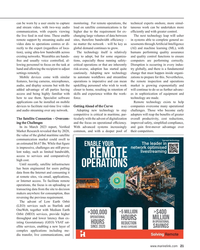 )
September 2023 - Maritime Reporter and Engineering News page: 21
)
September 2023 - Maritime Reporter and Engineering News page: 21,ooo Orbit (MEO) services, provide higher operational throughput and lower latency than ex- million hours in operational isting Geostationary (GEO) VSAT sat- hours reduction ellite services, enabling a new layer of since 2020 in hse exposure savings complex applications including me- dia transfer
-
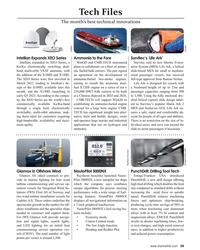 )
February 2023 - Maritime Reporter and Engineering News page: 39
)
February 2023 - Maritime Reporter and Engineering News page: 39new Marine Evacu- Ku/Ka electronically switching dual- plans to collaborate on a ? eet of ammo- ation System (MES) Life Ark, a helical band multi-orbit VSAT antennas, with nia fueled bulk carriers. The pair signed slide-based MES for small to medium- the addition of the X100D and X150D. an agreement
-
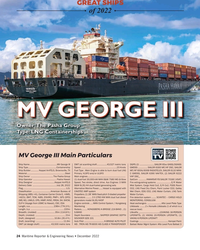 )
December 2022 - Maritime Reporter and Engineering News page: 24
)
December 2022 - Maritime Reporter and Engineering News page: 24........................................Pasha Hawaii (1) dual-fuel 30,000-kW MAN B&W 7S80 ME-GI-Slow SatCom .............INMARSAT-FB SAILOR 7016C (VSAT) Ship Designer .....................................Keppel AmFELS Speed, Two stroke, direct drive. Aux Engines: 3 MAN Fire extinguishing systems
-
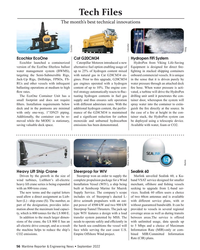 )
September 2022 - Maritime Reporter and Engineering News page: 56
)
September 2022 - Maritime Reporter and Engineering News page: 56won an order to supply the Marlink unveiled Sealink 60, a Ku- wind turbines, Liebherr’s all-electric complete propulsion package for a Wind band VSAT service designed for smaller heavy lift crane series is being expanded Installation Vessel (WIV), a ship being merchant, offshore and ? shing vessels
-
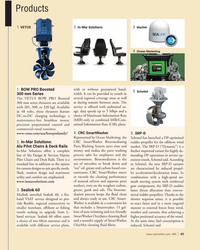 )
September 2022 - Marine News page: 43
)
September 2022 - Marine News page: 43than conven- 3. Sealink 60 Marlink unveiled Sealink 60, a Ku- diation process keeps the ? uid clean tional rudder propellers. Thanks to the band VSAT service designed to pro- and always ready to use. CRC Smart- shorter response times, it is possible vide ? exible, regional connectivity to Washer
-
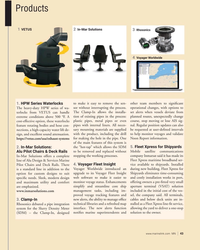 )
June 2022 - Marine News page: 43
)
June 2022 - Marine News page: 43monitor voyage status. Enhancements offering owners a pre-? tted very small are emphasized. simplify and streamline core ship aperture terminal (VSAT) solution www.inmarsolutions.com management tasks, including im- included in the initial cost of the ves- proved voyage tracking features and sel
-
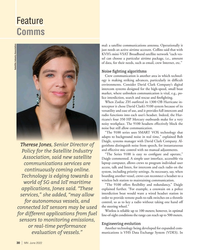 )
June 2022 - Marine News page: 30
)
June 2022 - Marine News page: 30Feature Comms mal: a satellite communications antenna. Operationally it just needs an active airtime account. Collins said that with KVH’s mini-VSAT Broadband satellite network “each ves- sel can choose a particular airtime package, i.e., amount of data, for their needs, such as email, crew Internet
-
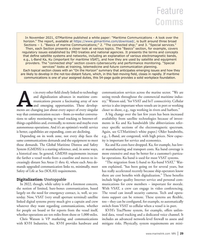 )
June 2022 - Marine News page: 29
)
June 2022 - Marine News page: 29that de? ne satellite systems and networks, including an explanation of various electromagnetic bands, e.g., L-Band Ka, Ku (important for maritime VSAT), and how they are used by satellite and equipment providers. The “connected ship” section covers cybersecurity and performance monitoring. “Special
-
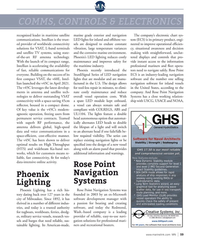 )
October 2021 - Marine News page: 59
)
October 2021 - Marine News page: 59primary product, engi- ed provider of worldwide connectivity sels are designed to endure constant neered to improve operational ef? cien- solutions for VSAT, L-band terminals vibration, large temperature variances cy, situational awareness and decision and satellite TV systems, using state- and the corrosive
-
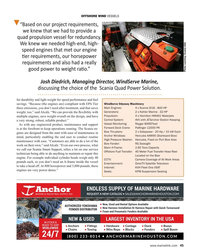 )
April 2021 - Maritime Reporter and Engineering News page: 45
)
April 2021 - Maritime Reporter and Engineering News page: 45inside the vessel Entertainment: DirecTV Satellite Television to take a head off. At 800 horsepower and 3,800 pounds, these Internet: KVH Fleet One VSAT engines are very power dense.” Seats: KPM Suspension Seating ENDLESS SUPPLY OF MARINE HARDWARE ! &"$)$?""?!!&"$l • New, Used and Rental Options Available A
-
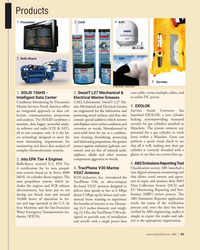 )
April 2021 - Marine News page: 43
)
April 2021 - Marine News page: 43mtu propul- Classi? cation society ABS launched a 4. TracPhone V30 Marine sion systems based on its Series 4000 new digital emissions monitoring tool VSAT Antenna M65L 16-cylinder diesel engines. The KVH Industries, Inc., introduced the that allows vessel owners and opera- mtu propulsion system, which
-
 )
February 2021 - Maritime Reporter and Engineering News page: 39
)
February 2021 - Maritime Reporter and Engineering News page: 39Then, to enable remote control, each vessel will have agnostic system being supplied by Kongsberg – so it’ll be two large satellite domes, in addition to VSAT and 3-5G able to deploy different ROVs, as well as AUVs. The sys- communications capability. “You can miniaturize ev- tem will deploy vehicles via
-
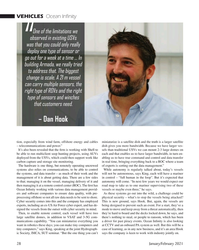 )
January 2021 - Marine Technology Reporter page: 28
)
January 2021 - Marine Technology Reporter page: 28, to enable remote control, each vessel will have two they’re hard to board and the decks locked down, he says, and large satellite domes, in addition to VSAT and 3-5G com- there’s nothing to steal, or people to ransom, which has been munications capability. “You can miniaturize everything you a driver for
-
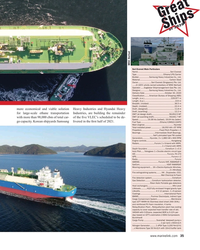 )
December 2020 - Maritime Reporter and Engineering News page: 35
)
December 2020 - Maritime Reporter and Engineering News page: 35...............................Furuno GMDSS ...................................Furuno VHF, INMARSAT C SatCom..................................................VSAT INMARSAT Mooring equipment ....16 x Electro-Hydraulic Winches, .....................................................................2 x Windlass Fire
-
 )
November 2020 - Maritime Reporter and Engineering News page: 51
)
November 2020 - Maritime Reporter and Engineering News page: 51the economic bene? ts tions services that are so important TESTING & ANALYSIS against possible health risk. This may today, it’s crucial that the right VSAT push both cruise lines and travelers to platform is in place. As cruise lines ALIGNMENT seek itineraries with smaller ports or gradually begin to
-
 )
October 2020 - Maritime Reporter and Engineering News page: 17
)
October 2020 - Maritime Reporter and Engineering News page: 17full set of solutions to provide creative set more, saving cost and increasing the ef? ciency of connectiv- hardware and service solutions which includes VSAT, VSAT ity,” said Darling. “Also the crew will expect more connec- fail over, GSM integration, voice service, a range of technol- tivity to home.” www
-
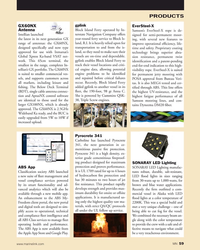 )
September 2020 - Marine News page: 59
)
September 2020 - Marine News page: 59safety. Proprietary coating approved for use with Inmarsat’s land, so they need to make sure their technology brings superior abra- Global Xpress Ka-band VSAT net- vessels are on-time and dependable. sion resistance, permanent twist work. This 65cm terminal, the gplink enables Block Island Ferry to identi
-
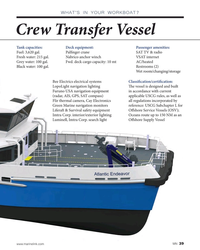 )
September 2020 - Marine News page: 39
)
September 2020 - Marine News page: 39Vessel Tank capacities: Deck equipment: Passenger amenities: Fuel: 3,620 gal. Palf n ger crane SAT TV & radio Fresh water: 215 gal. Nabrico anchor winch VSAT internet Grey water: 100 gal. Fwd. deck cargo capacity: 10 mt AC/heated Black water: 100 gal. Restrooms (2) Wet room/changing/storage Bee Electrics
-
 )
July 2020 - Maritime Reporter and Engineering News page: 22
)
July 2020 - Maritime Reporter and Engineering News page: 22changing demands. For seamless transition between shore-based 4G/LTE connectivity, instance, being able to support real-time analysis of integrated VSAT and L-band satellite, to the operation of on-board in- data from IoT sensors or provide video conferencing, voice 22 Maritime Reporter & Engineering
-
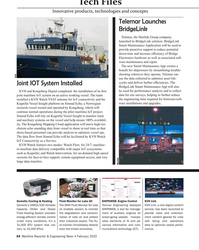 )
February 2020 - Maritime Reporter and Engineering News page: 64
)
February 2020 - Maritime Reporter and Engineering News page: 64and to collect joint maritime IoT system on an active working vessel. The team data for site surveys, helping to further reduce installed a KVH Watch VSAT antenna for IoT connectivity and the the engineering time required for ? rmware/soft- Kognifai Vessel Insight platform on Simrad Echo, a Norwegian
-
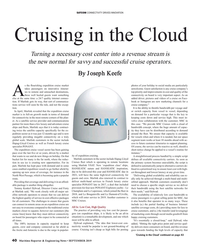 )
September 2019 - Maritime Reporter and Engineering News page: 40
)
September 2019 - Maritime Reporter and Engineering News page: 40is operating in remote locations the primary system becomes unavailable, the script is part, Marlink has kept pace with demand and in some using Marlink VSAT. New ‘expedition class’ ships, de? ned to automatically jump to alternative carriers de- cases enabled expedition vessels to go further a? eld by
-
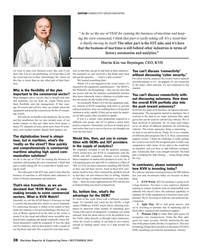 )
September 2019 - Maritime Reporter and Engineering News page: 38
)
September 2019 - Maritime Reporter and Engineering News page: 38SATCOM CONNECTIVITY DRIVES INNOVATION “As far as the use of VSAT for running the business of maritime and keep- ing the crew connected, I think that part is really taking off. It’s a trend that is ? nally moving by itself. The other part is the IOT side, and it’s here that the business of maritime is
-
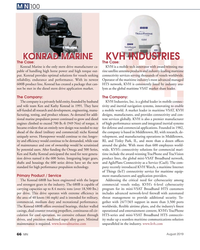 )
August 2019 - Marine News page: 66
)
August 2019 - Marine News page: 66that can- HTS network, KVH is consistently listed by industry ana- not be met in the diesel stern drive application market. lysts as the global maritime VSAT market share leader. The Company: The Company: The company is a privately held entity, founded by husband KVH Industries, Inc. is a global leader in
